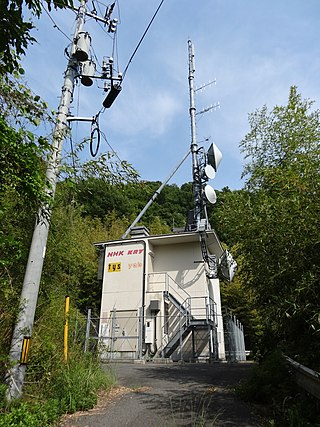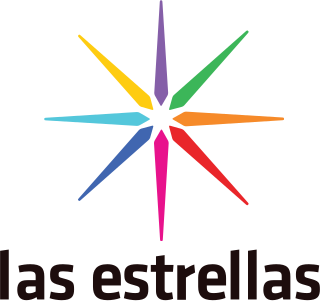The International Telecommunication Union (ITU) allocates call sign prefixes for radio and television stations of all types. They also form the basis for, but may not exactly match, aircraft registration identifiers. These prefixes are agreed upon internationally, and are a form of country code. A call sign can be any number of letters and numerals but each country must only use call signs that begin with the characters allocated for use in that country.
Station identification is the practice of radio and television stations and networks identifying themselves on-air, typically by means of a call sign or brand name. This may be to satisfy requirements of licensing authorities, a form of branding, or a combination of both. As such, it is closely related to production logos, used in television and cinema alike.

KCBS is an all-news AM radio station located in San Francisco, California. It is owned by Audacy, Inc., which took over after its merger with CBS Radio.
In broadcasting and radio communications, a call sign is a unique identifier for a transmitter station. A call sign can be formally assigned by a government agency, informally adopted by individuals or organizations, or even cryptographically encoded to disguise a station's identity.
Call signs in New Zealand are no longer generally used to identify broadcast stations. However, New Zealand's radio stations were once known by their call signs and would usually broadcast their call signs as a number followed by X, Y, or Z, and another letter. Call signs are regulated internationally by the ITU and nationally by the Ministry of Business, Innovation and Employment (MBIE), formerly the Ministry of Economic Development. The ministry is also responsible for providing policy advice to Government on the allocation of New Zealand's radio spectrum to support, efficient, reliable and responsive wireless telecommunications and broadcasting infrastructure.

A broadcast relay station, also known as a satellite station, relay transmitter, broadcast translator (U.S.), re-broadcaster (Canada), repeater or complementary station (Mexico), is a broadcast transmitter which repeats the signal of a radio or television station to an area not covered by the originating station.
Call signs in Australia are allocated by the Australian Communications and Media Authority and are unique for each broadcast station. The use of callsigns on-air in both radio and television in Australia is optional, so many stations used other on-air identifications. Australian broadcast stations officially have the prefix VL- and originally all callsigns used that format, but since Australia has no nearby neighbours, this prefix is no longer used except in an international context.

Las Estrellas is one of the cornerstone networks of TelevisaUnivision, with affiliate stations all over Mexico, flagshipped at XEW-TDT in Mexico City. Many of the programs of Las Estrellas are seen in the United States on Univision, UniMás, and Galavisión.
Call signs in Argentina are unique identifiers for communication. Call signs are regulated internationally by the ITU as well as nationally by the Comisión Nacional de Comunicaciones of the Argentine government.
Amateur radio call signs are allocated to amateur radio operators around the world. The call signs are used to legally identify the station or operator, with some countries requiring the station call sign to always be used and others allowing the operator call sign instead.
Call signs in Russia are unique identifiers for telecommunications and broadcasting. Call signs are regulated internationally by the ITU as well as nationally by Ministry of Communications and Mass Media of the Russian Federation. The latter is responsible for providing policy on the allocation of Russia's radio spectrum to support efficient, reliable and responsive wireless telecommunications and broadcasting infrastructure.
Call signs in Mexico are unique identifiers for telecommunications, radio communication, radio broadcasting and transmission. They are regulated internationally by the International Telecommunication Union (ITU) as well as nationally by the Federal Telecommunications Institute, which regulates broadcast stations, wireless telecommunications and spectrum use.
Call signs in Korea are unique identifiers for telecommunications and broadcasting on the Korean peninsula. Call signs are regulated internationally by the ITU as well as nationally in South Korea by the Korea Communications Commission in the Ministry of Information and Communication. Not much is known outside of North Korea how amateur radio is regulated, although a foreign amateur was asked to appear before the "Radio Regulation Board" in 2002. Also, North Korea's Cultural Relations with Foreign Countries recently issued an operating permit, which was countermanded by the Ministry of Telecommunications and Posts.
Call signs in Asia are rarely used to identify broadcast stations. In most Asian countries, broadcast stations use other forms of identification. Few countries west of the Pacific Ocean, namely Japan, South Korea, Indonesia, the Philippines and Taiwan are exceptions to this rule. Amateur radio stations in India, Pakistan, Korea and Japan are allocated call-signs.
Call signs in Europe are not formally used for broadcast stations.
Call signs in South America are used for a variety of purposes, including identifying radio and TV stations. Argentina and Brazil both have broadcast call signs systems. Some stations still broadcast their call signs a few times a day, but this practice is becoming very rare. Call signs were first assigned to South American countries in 1913, and the call sign blocks were expanded to include amateur radio in 1947.
Call signs in Canada are official identifiers issued to the country's radio and television stations. Assignments for broadcasting stations are made by the Canadian Radio-television and Telecommunications Commission (CRTC), while amateur stations receive their call signs from Innovation, Science and Economic Development Canada. Conventional radio and television broadcasting stations assignments are generally three, four or five letters long and almost exclusively use "C" call signs; with a few exceptions noted below, the "V" calls are restricted to specialized uses such as amateur radio.
Call signs in the United States are identifiers assigned to radio and television stations, which are issued by the Federal Communications Commission (FCC) and, in the case of most government stations, the National Telecommunications and Information Administration (NTIA). They consist of from 3 to 9 letters and digits, with their composition determined by a station's service category. By international agreement, all call signs starting with the letters K, N, and W, as well as AAA-ALZ, are reserved exclusively for use in the United States.
Broadcast call signs are call signs assigned as unique identifiers to radio stations and television stations. While broadcast radio stations will often brand themselves with plain-text names, identities such as "cool FM", "rock 105" or "the ABC network" are not globally unique. Another station in another city or country may have a similar brand, and the name of a broadcast station for legal purposes is normally its internationally recognised ITU call sign. Some common conventions are followed around the world.
The rules governing call signs for stations in the United States are set out in the FCC rules, 47 C.F.R. chapter I. Specific rules for each particular service are set out in the part of the rules dealing with that service. A general overview of call sign formats is found at 47 CFR 2.302 . Rules for broadcast stations' call sign are principally defined in 47 CFR 73.3550 .



